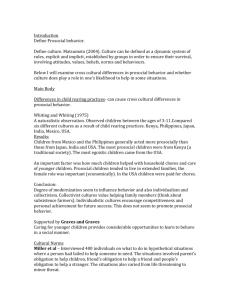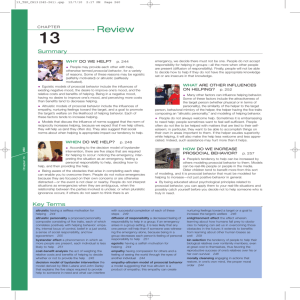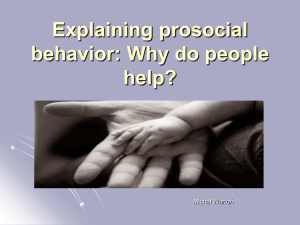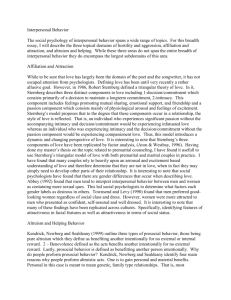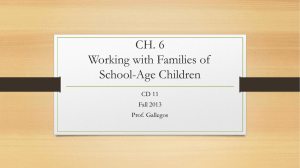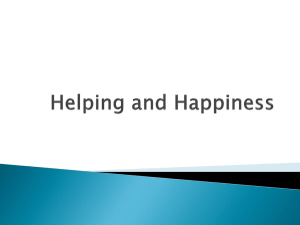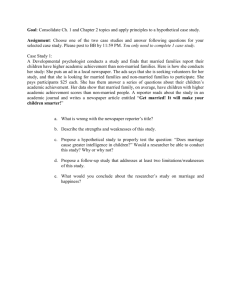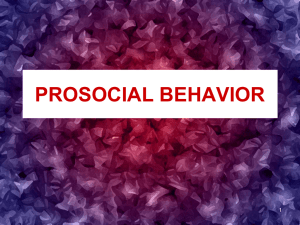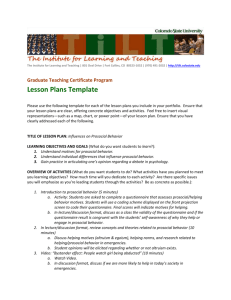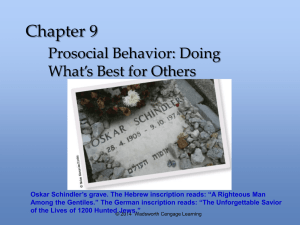Prosocial Behavior Basic Motives Underlying Prosocial Behavior
advertisement
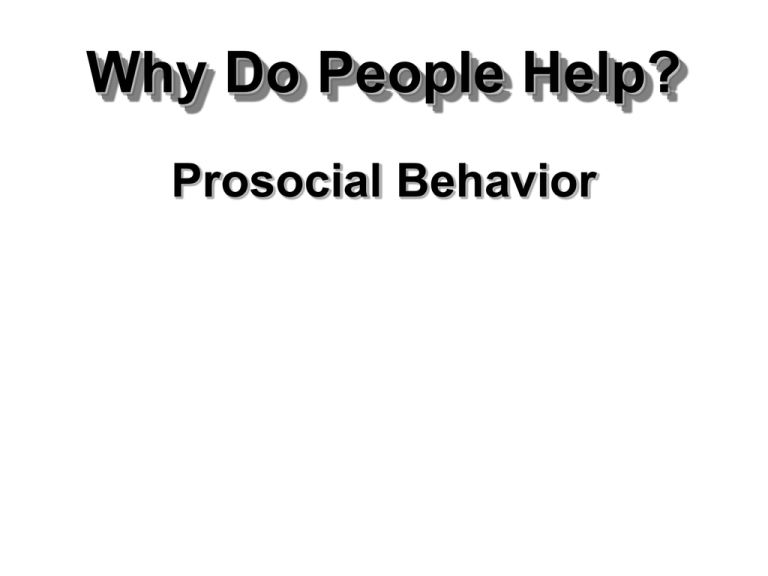
Why Do People Help? Prosocial Behavior Basic Motives Underlying Prosocial Behavior Prosocial behavior is any act performed with the goal of benefiting another person. Basic Motives Underlying Prosocial Behavior Altruism is the desire to help another person even if it involves a cost to the helper. Basic Motives Underlying Prosocial Behavior A basic question that people have asked is whether people are willing to help when there is nothing to gain, or if they only help when there is some benefit for them. Theories of Prosocial Behavior • Evolutionary • Social exchange • Empathy-altruism Basic Motives Underlying Prosocial Behavior • Evolutionary Psychology: Instincts and Genes Evolutionary Psychology is the attempt to explain social behavior in terms of genetic factors that evolved over time, according to the principles of natural selection. Basic Motives Underlying Prosocial Behavior • Evolutionary Psychology: Instincts and Genes Darwin recognized that altruistic behavior posed a problem for his theory: if an organism acts altruistically, it may decrease its own reproductive fitness. Basic Motives Underlying Prosocial Behavior • Evolutionary Psychology: Instincts and Genes The idea of kin selection is the idea that behaviors that help a genetic relative are favored by natural selection. Basic Motives Underlying Prosocial Behavior • Evolutionary Psychology: Instincts and Genes The norm of reciprocity is the expectation that helping others will increase the likelihood that they will help us in the future. Basic Motives Underlying Prosocial Behavior • Social Exchange: The Costs and Rewards of Helping Social exchange theory argues that much of what we do stems from the desire to maximize our outcomes and minimize our costs. Like evolutionary psychology, it is a theory based on self-interest; unlike it, it does not assume that self-interest has a genetic basis. Basic Motives Underlying Prosocial Behavior • Social Exchange: The Costs and Rewards of Helping Helping can be rewarding because increases the probability that _____________________ relieves the _______________of the bystander gains us ___________and increased ______________. Basic Motives Underlying Prosocial Behavior • Social Exchange: The Costs and Rewards of Helping Helping can also be costly (danger, time, money); thus it decreases when costs are high. Basic Motives Underlying Prosocial Behavior • Empathy and Altruism: The Pure Motive for Helping Batson (1991) is the strongest proponent of the idea that people often help purely out of the goodness of their hearts. Basic Motives Underlying Prosocial Behavior • Empathy and Altruism: The Pure Motive for Helping He argues that pure altruism is most likely to come into play when we experience empathy for the person in need; that is, we are able to experience events and emotions the way that person experiences them. Basic Motives Underlying Prosocial Behavior • Empathy and Altruism: The Pure Motive for Helping The empathy-altruism hypothesis states that when we feel empathy for a person, we will attempt to help purely for altruistic reasons, that is, regardless of what we have to gain. Empathy and Altruism: The Pure Motive for Helping Empathy and Altruism: The Pure Motive for Helping • • • When did people agree to help Carol (who was in auto accident) w/work missed in Intro Psych? (Toi & Batson,1982) High empathy: Imagine how Carol felt Low Empathy: Be objective, don’t be concerned w/ how Carol felt Altruistic or egoistic motives • Hard to disentangle • If feel good after helping someone, was the motive altruistic or egoistic? • Personal Determinants of Prosocial Behavior Individual Differences: The Altruistic Personality Aspects of a person’s makeup that lead the person to help others in a wide variety of situations defines the altruistic personality. • Personal Determinants of Prosocial Behavior Individual Differences: The Altruistic Personality Research has found that the extent to which people are helpful in one situation is NOT highly related to how prosocial they are in another situation. Personality is not the only determinant of whether people will help, at least across many situations. • Personal Determinants of Prosocial Behavior Individual Differences: The Altruistic Personality It appears that different kinds of people are likely to help in different types of situations. Gender Differences in Prosocial Behavior Eagly and Crowly (1986) found that men are more likely to help in ________________ways, and women are more likely to help in ___________involving ________________. Ex: Men __________to help w/flat tire or in dangerous situation. (short-term, strangers) Women _________to help take care of a neighbor or elderly relative. (longer-term, close relationships) Gender differences in receiving help • Are people more likely to help women or men? It depends. – Male helpers are ______likely to help __________________. – Female helpers are ______likely to help______________. • Women not only receive _____help from men, but they also ________help. • Personal Determinants of Prosocial Behavior Cultural Differences in Prosocial Behavior People across cultures are more likely to help members of their in-group, the group with which an individual identifies as a member, than members of the out-group, a group with which an individual does not identity. • Personal Determinants of Prosocial Behavior Cultural Differences in Prosocial Behavior People from collectivist cultures are more prone to help in-group members and less likely to help out-group members than are people from individualist cultures. • Personal Determinants of Prosocial Behavior The Effects of Mood on Prosocial Behavior People who are in a good mood are more likely to help. • Personal Determinants of Prosocial Behavior The Effects of Mood on Prosocial Behavior Good moods can increase helping for three reasons good moods make us interpret events in a _____________way helping another _____________________ good moods ___________self-attention, and this in turn leads us to be ________to behave according to our values and beliefs. Feel good, do good • EXAMPLE: Isen, Clark, & Schwartz, 1976: • IV: A confederate, who had supposedly spent her last dime on a wrong number, called people who had received a free sample of stationery 0-20 minutes earlier or who had not received a gift. • DV: Helping=willingness to relay a phone message • Results: People who had received a free gift in the previous 5 mins. were ___________to relay a message than control subjects who had not received gift. Positive Mood: Feel good, do good • When researchers have induced a good mood (e.g., leaving dimes in the coin return slot of a pay phone, giving people cookies, etc.), they find that people in a good mood are ___________to help than those in a “neutral” mood. • Personal Determinants of Prosocial Behavior The Effects of Mood on Prosocial Behavior Negative-state relief hypothesis says that people help in order to alleviate their own sadness and distress; it exemplifies a social exchange approach. Negative mood and helping • EX: Thompson, Cowan, & Rosenhan, 1980 • IV: Focused on own feelings about their dying friend or the friend’s feelings (negative mood was induced) • DV: Anonymously helping a grad student with her research • Results: ___________to help in the otherfocused condition (____%) versus self-focused condition (___%). How can a sad mood and a happy mood both lead to more helping? • Different reasons • Sadness: Helping _____________mood. (But, if we blame others for our bad mood, sadness is not associated with more helping.) Complex association. • Happiness: May trigger ___________about others. May prolong good mood. Straightforward, consistent association. • Situational Determinants of Prosocial Behavior Environments: Rural versus Urban People in rural areas are more helpful. This effect holds over a wide variety of helping situations and in many countries. • Situational Determinants of Prosocial Behavior Environments: Rural versus Urban One explanation is that people from rural settings are brought up to be more neighborly and more likely to trust strangers. • Situational Determinants of Prosocial Behavior The Number of Bystanders: The Bystander Effect The bystander effect is the finding that the greater the number of bystanders who witness an emergency, the less likely any one of them is to help. • Situational Determinants of Prosocial Behavior The Number of Bystanders: The Bystander Effect Latané and Darley (1970) developed a decision tree to show how people decide whether to help in an emergency: 1. Noticing an Event: Yes No 2. Interpreting the Event as an Emergency Yes No 3. Assuming Responsibility Yes No 4. Knowing How to Help Yes No 5. Deciding to Implement the Help Yes No Stage 1: Noticing the event • The Good Samaritan study Stage 1: Noticing the event Darley & Batson, 1973 TIME PRESSURE • IVs: Hurry or No Hurry • Topic of talk: Good Samaritan parable or jobs for seminary students • DV: Helping a man slumped in doorway • Results: No hurry condition: Hurry condition: Topic of speech was ____________to helping. Kitty Genovese case • Was noticing the event a problem? Stage 2: Interpreting the event as an emergency • Smoke-filled room study – video clip • Situational Determinants of Prosocial Behavior The Number of Bystanders: The Bystander Effect Pluralistic ignorance is the phenomenon whereby bystanders assume that nothing is wrong in an emergency because no one else looks concerned. This greatly interferes with the interpretation of the event as an emergency and therefore reduces helping. Kitty Genovese • Was interpreting the event a problem in the Kitty Genovese case? Stage 3: Assuming responsibility • Recall seizure study (earlier in the course) • When more people were present, participants were less likely to help (by getting the experimenter) and they took longer to help (if they did help). Situational Determinants of Prosocial Behavior Stage 3: Assuming responsibility Diffusion of responsibility is the phenomenon whereby each bystander’s sense of responsibility to help decreases as the number of witnesses increases. This results in a reduction of helping. Kitty Genovese • Was assuming responsibility a problem? Stage 4: Weighing rewards and costs • People help when the rewards outweigh the costs • Potential rewards – Reciprocity – Social approval – Self-satisfaction – Reduced guilt and arousal • Potential costs – Danger/life threatening – Financially detrimental – Embarrassing – Time consuming • Kitty Genovese? Stage 5: Deciding how to help • People cannot help if they do not know how to help. • Do you know CPR? The Heimlich maneuver? Your own blood type? • This is not an issue in the case of Kitty Genovese. • Situational Determinants of Prosocial Behavior The Nature of the Relationship: Communal Versus Exchange Relationships Communal relationships are those in which people’s primary concern is with the welfare of the other, whereas exchange relationships are governed by equity concerns. • Situational Determinants of Prosocial Behavior The Nature of the Relationship: Communal Versus Exchange Relationships Generally we are more helpful towards_____________________; the exception occurs when the ______________us in a domain that is _________________and thus threatens our self-esteem. (Recall Tesser video) How Can Helping Be Increased? • Prosocial role models • 1--Bryan & Test (1967) L.A. drivers were ____________to offer help to a female driver with a flat tire if a quarter of a mile earlier they had witnessed someone helping another woman change a tire. Increasing helping—Prosocial models • 2—Byran & Test (1967) New Jersey Xmas shoppers were ___________to drop money into a Salvation Army kettle if they had just seen someone else to donate. Increasing helping—prosocial models • 3—Rushton & Campbell (1977) found British adults ____________to donate blood if they were approached after observing a confederate agree to donate. Media can encourage helping • • • • TV programming NIMH study of Mr. Rogers 4 wks preschool program Kids from _____________homes became __________________________________ __________during the 4 wk period than those who did not see the show. Increasing helping: Disseminate research findings • Beaman et al. (1978) Students who had heard a lecture on bystander intervention were more likely to help in a staged emergency 2 wks later. • Heard lecture _____% helped • Did not hear lecture ____% helped
